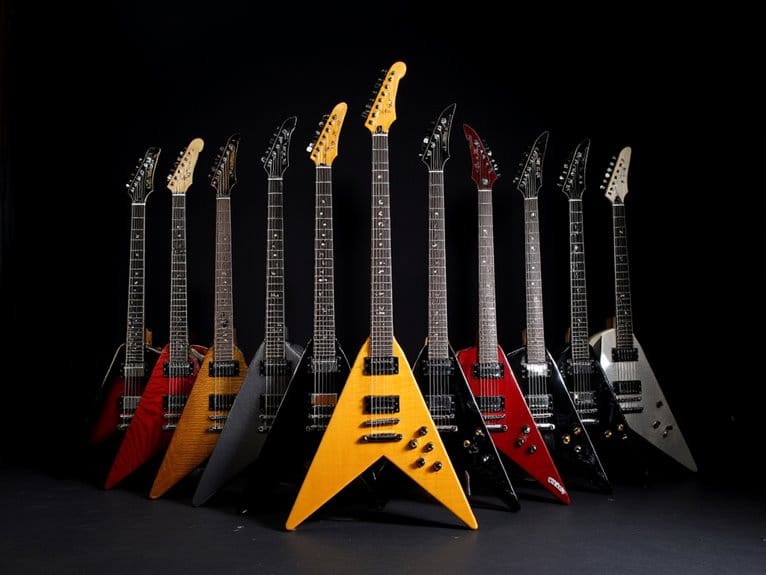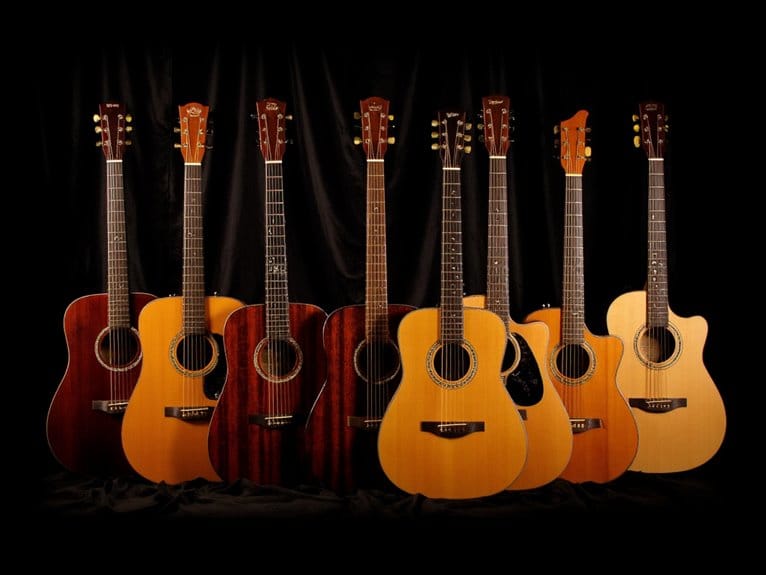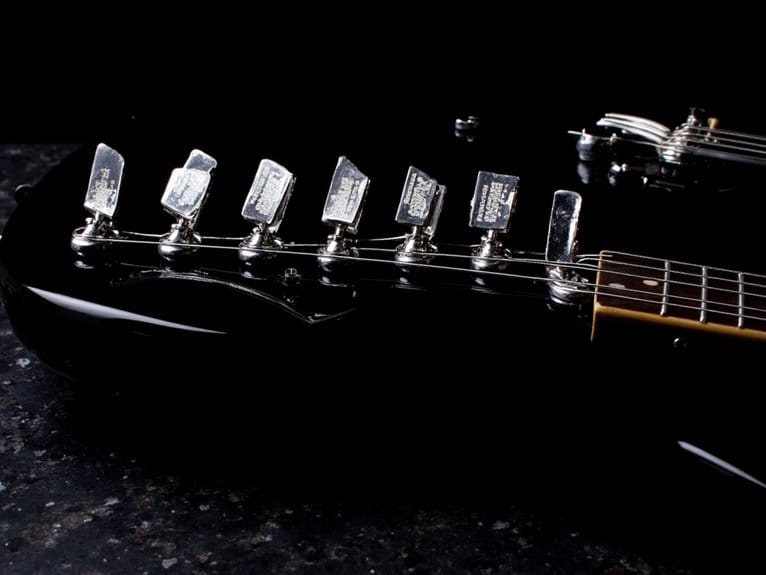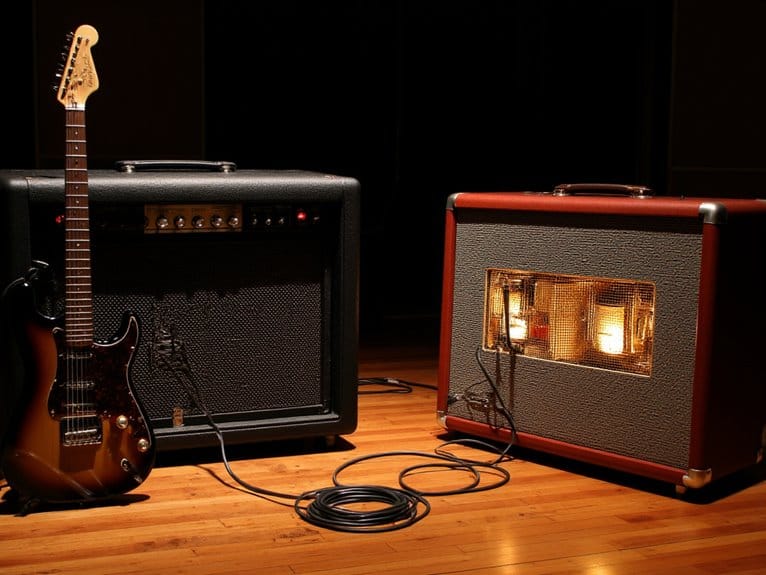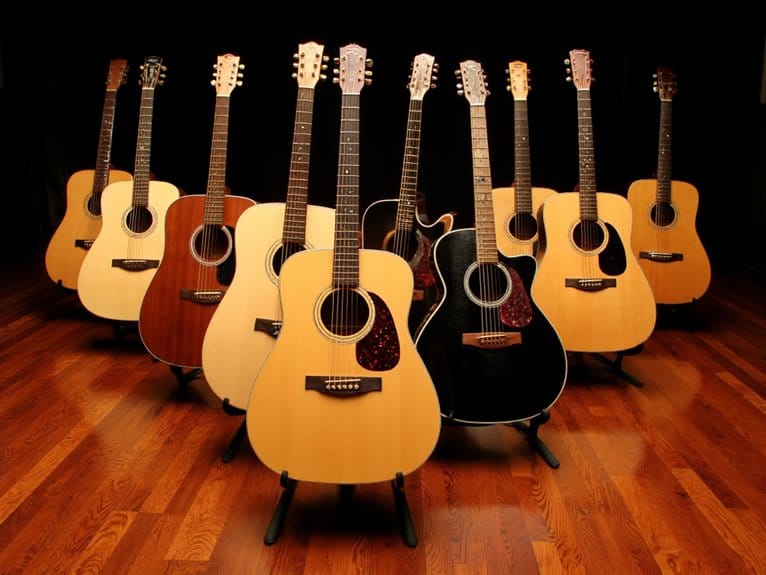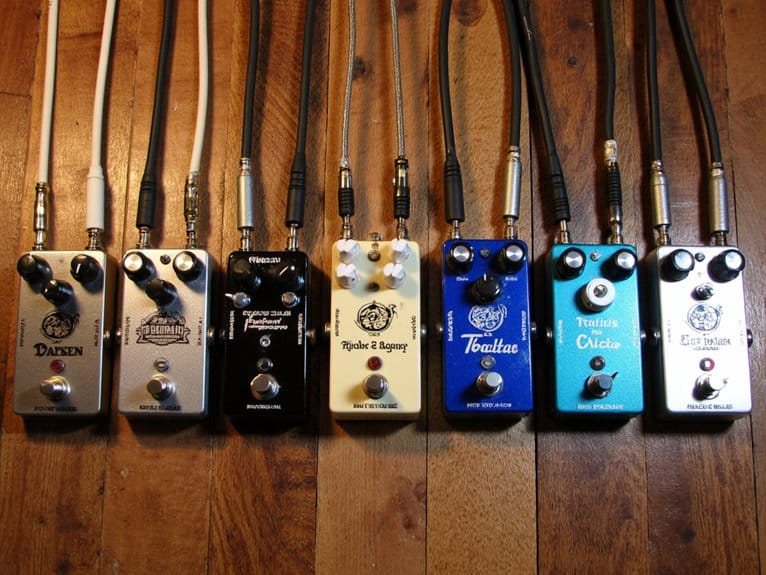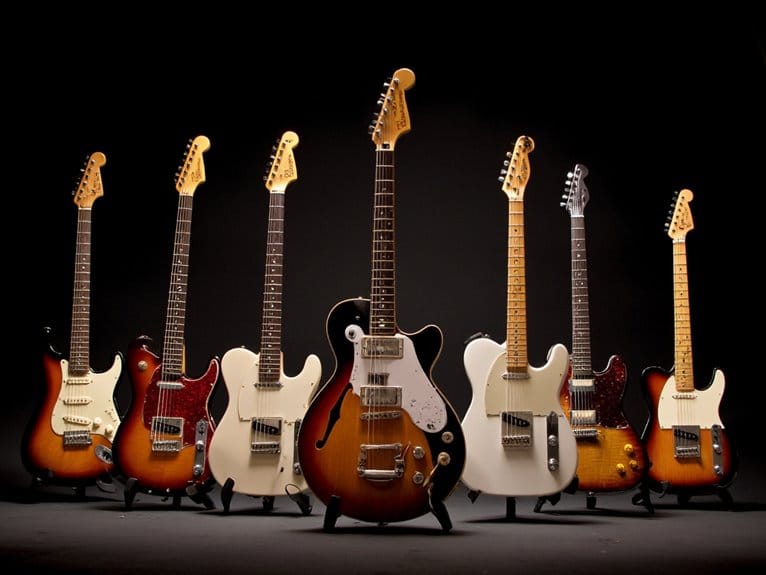10 Best Flying V Guitars That Rock Hard and Look Even Better
I’ve tested dozens of Flying V guitars, and the standouts include the Epiphone EXCLUSIVE Flying V Purple Sparkle with its ProBucker humbuckers and string-thru design for exceptional sustain, the Jackson JS32 King V models offering aggressive aesthetics with high-output ceramics perfect for metal, and the JS22 HT 7-string for extended range capabilities. These models balance striking visuals with solid construction, though budget options may require professional setups for peak performance—factors I’ll explore further below.
We are supported by our audience. When you purchase through links on our site, we may earn an affiliate commission, at no extra cost for you. Learn more.
Notable Insights
- Flying V guitars combine striking aesthetics with powerful sound, featuring bold finishes and aggressive designs perfect for rock and metal genres.
- Top models include Epiphone Flying V with ProBucker humbuckers and Jackson King V series with high-output ceramics for robust tones.
- Key features like string-through tailpieces, compound-radius fingerboards, and Floyd Rose tremolo systems enhance sustain and playability for advanced techniques.
- Price ranges from budget models around $200 to premium options over $1,500, with mid-tier guitars offering optimal quality-to-cost ratios.
- Essential considerations include body wood selection, pickup configurations, neck profiles, and bridge systems that directly impact tone and performance capabilities.
Epiphone EXCLUSIVE Flying V, Purple Sparkle
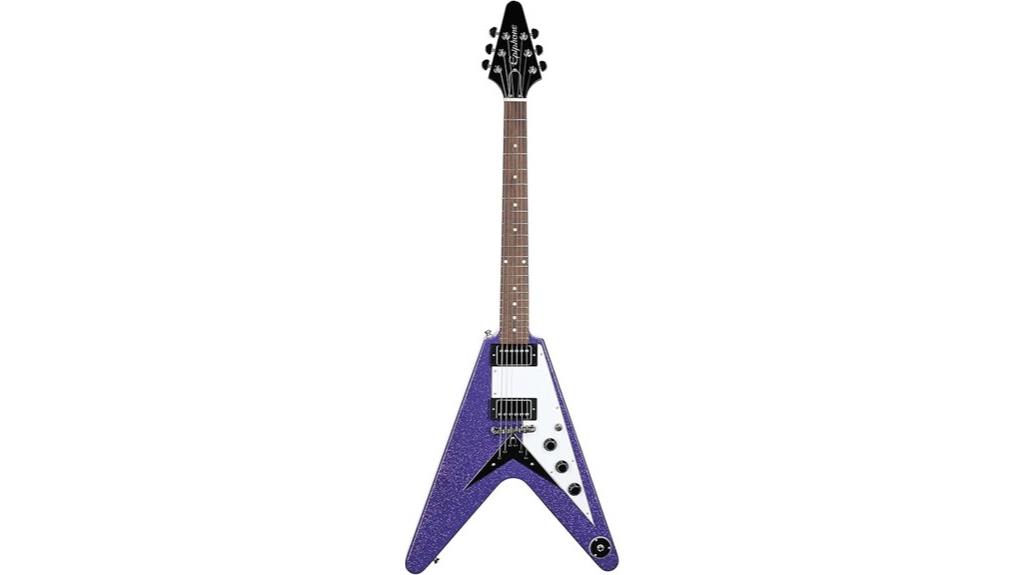
When I first encountered the Epiphone EXCLUSIVE Flying V in Purple Sparkle, I knew I’d found something special for guitarists who demand both visual impact and serious performance capabilities. This striking instrument combines Epiphone’s ProBucker humbuckers with era-appropriate wiring and CTS potentiometers, delivering authentic vintage tone that’ll cut through any mix. The string-thru tailpiece enhances sustain while Epiphone Vintage Deluxe tuners guarantee rock-solid stability, even during aggressive playing sessions. I particularly appreciate the rolled neck design, which provides exceptional comfort during extended performances, and the Graph Tech NuBone nut contributes to improved string resonance and clarity throughout the fretboard’s range.
Best For: Guitarists who want a visually striking Flying V with authentic vintage tone, reliable hardware, and comfortable playability for both studio recording and live performance.
Pros:
- ProBucker humbuckers with era-appropriate wiring and CTS potentiometers deliver authentic vintage tone
- String-thru tailpiece and Vintage Deluxe tuners provide enhanced sustain and rock-solid tuning stability
- Rolled neck design and Graph Tech NuBone nut offer exceptional comfort and improved string resonance
Cons:
- Flying V body shape may be uncomfortable for some players, especially when sitting
- Purple Sparkle finish, while striking, may not appeal to players seeking more traditional guitar aesthetics
- Humbucker-only pickup configuration limits tonal versatility compared to guitars with single-coil options
Jackson JS Series King V JS32 – Gloss Black
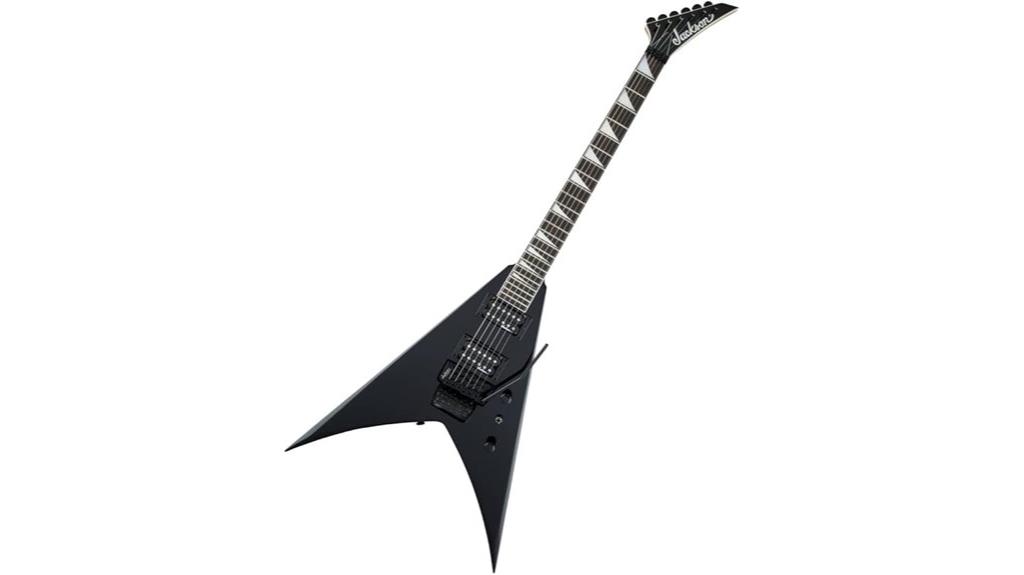
For guitarists craving the aggressive aesthetics of metal and rock without breaking the bank, the Jackson JS Series King V JS32 in Gloss Black delivers iconic stage presence through its sharp, angular silhouette that commands attention in any performance setting. You’ll appreciate the poplar body’s lightweight construction paired with a maple speed neck, creating smooth playability across the compound-radius amaranth fingerboard that accommodates both aggressive chords and soaring bends without fretting out. The high-output ceramic humbuckers produce thick, snarling tones perfect for metal genres, though you might need to fine-tune the Floyd Rose licensed tremolo system for peak stability after purchase.
Best For: Beginner to intermediate guitarists seeking an affordable metal and rock guitar with iconic King V aesthetics and high-output sound without sacrificing build quality.
Pros:
- Lightweight poplar body with smooth maple speed neck provides excellent playability for both chording and lead techniques
- High-output ceramic humbuckers deliver thick, aggressive tones perfect for metal and rock genres
- Exceptional value for money with iconic King V design and quality construction at an affordable price point
Cons:
- Floyd Rose licensed tremolo system requires fine-tuning and adjustments out of the box for optimal stability
- Unique V-shaped body requires specific guitar stands and may be less comfortable for some playing positions
- May need pickup or hardware upgrades to compete with higher-end models for professional use
Jackson JS Series King V JS32 – White with Black Bevels
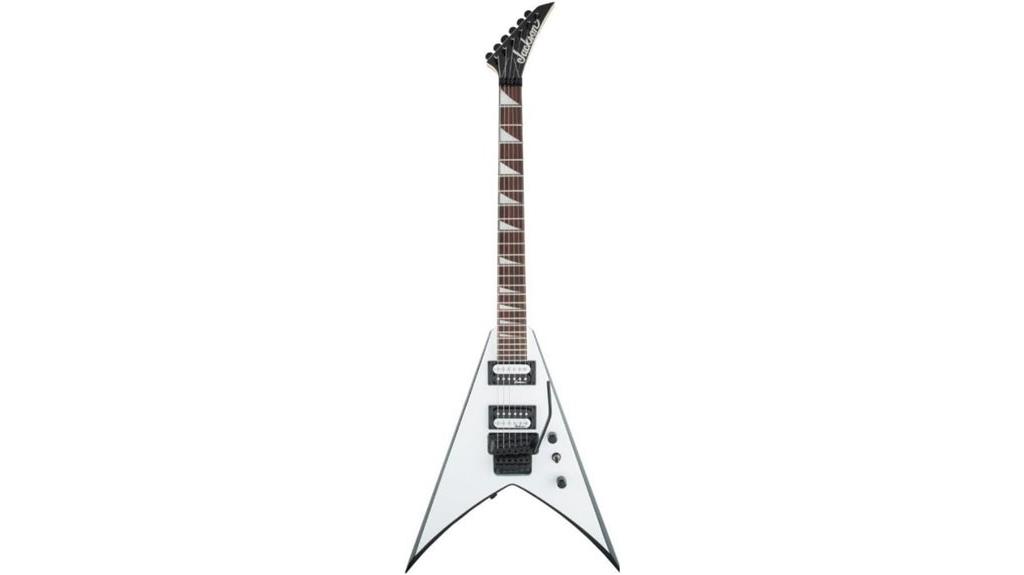
The Jackson JS Series King V JS32 in White with Black Bevels delivers aggressive metal tones and lightning-fast playability that’ll satisfy shredders and hard rock enthusiasts who demand both visual impact and serious performance. You’ll appreciate the compound-radius fingerboard, which shifts from 12 inches for comfortable chord work to 16 inches for blazing lead runs, while the maple speed neck and jumbo frets facilitate effortless navigation across the 25.5-inch scale length. The dual humbuckers produce thick, snarling tones with impressive sustain from the lightweight poplar body, though you might consider upgrading the pickups and tremolo system for enhanced performance consistency.
Best For: Metal players, shredders, and hard rock guitarists who want an aggressive-looking instrument with fast playability and thick, sustaining tones for lead work and heavy rhythm playing.
Pros:
- Compound-radius fingerboard (12″ to 16″) and maple speed neck with jumbo frets provide exceptional playability for both chords and fast lead runs
- Lightweight poplar body delivers impressive sustain and thick, snarling tones through dual humbucking pickups
- Striking visual appeal with classic King V shape in white with black bevels at an accessible price point
Cons:
- Quality control issues reported including pickup looseness, tremolo problems, and string buzz requiring professional setup
- Stock components (pickups, tremolo, tuners) may need upgrading for optimal performance consistency
- Setup issues upon arrival that can affect initial playability and tuning stability
Jackson King V JS22 HT 7-string Electric Guitar – Satin Black
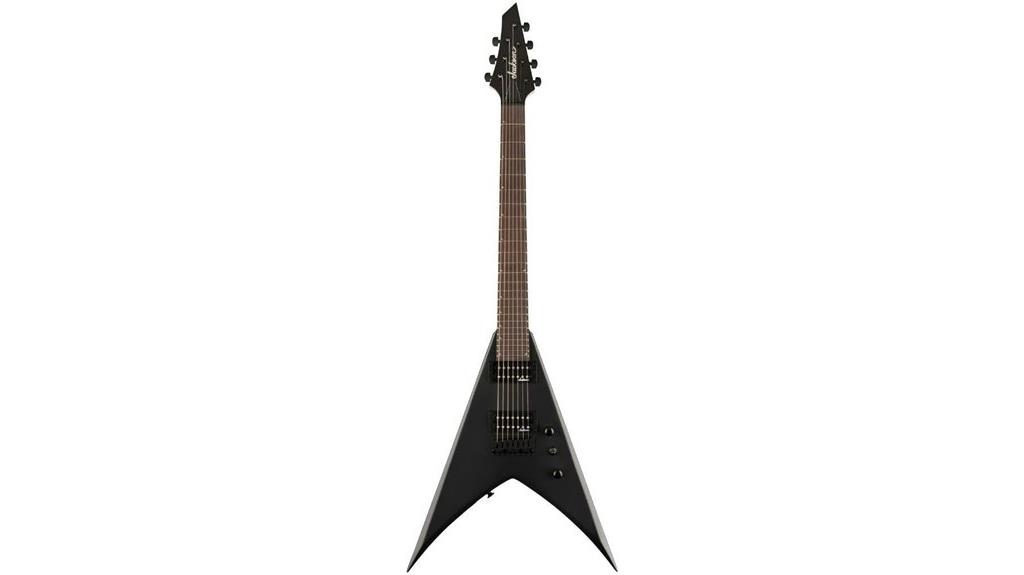
Seven strings and aggressive aesthetics converge in the Jackson King V JS22 HT, a guitar that transforms extended-range playing from a luxury into an accessible reality for metal enthusiasts and progressive players. You’ll appreciate the poplar body’s lightweight construction, which delivers surprising sustain and sonic detail despite its modest price point. The amaranth fretboard features a compound radius design that accommodates both rhythm chording and lead work, though you should expect to invest in a professional setup upon arrival. Two Jackson humbuckers provide noise-free operation with enough output for high-gain applications, while the hard-tail bridge maintains tuning stability across all seven strings.
Best For: Metal enthusiasts and progressive players seeking an affordable entry into 7-string extended-range playing with aggressive V-shaped aesthetics.
Pros:
- Lightweight poplar body delivers surprising sustain and sonic detail for the price point
- Two Jackson humbucking pickups provide noise-free operation with sufficient output for high-gain applications
- Compound radius amaranth fretboard accommodates both rhythm chording and lead work effectively
Cons:
- Requires professional setup upon arrival as playability issues are commonly reported out of the box
- Neck width may be challenging for players accustomed to standard 6-string guitars
- Initial quality control issues with action and fret buzz frequently mentioned in user feedback
Jackson JS Series King V JS32T Electric Guitar (Ferrari Red)
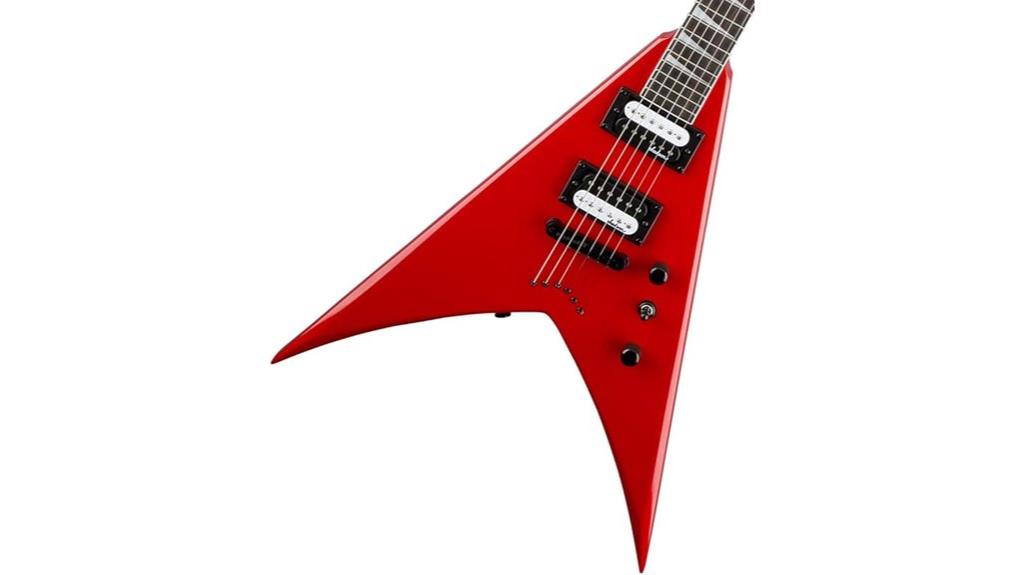
Intermediate guitarists seeking an affordable entry into the iconic Flying V silhouette will find compelling value in Jackson’s JS Series King V JS32T Electric Guitar, particularly in its striking Ferrari Red finish that commands attention on any stage. The poplar body, while not premium tonewood, delivers solid fundamentals paired with a 25.5″ maple neck that provides reliable playability across its 24-fret amaranth fingerboard. Dual Jackson high-output humbuckers offer respectable tone versatility, though some players report needing upgrades for professional applications. With a 4.2-star rating from customers, this guitar represents Jackson’s commitment to accessible quality, even if the poplar construction occasionally limits tonal complexity compared to higher-end models.
Best For: Intermediate guitarists looking for an affordable entry into the iconic Flying V shape with eye-catching Ferrari Red aesthetics and solid playability fundamentals.
Pros:
- Striking Ferrari Red finish with classic King V silhouette that stands out on stage
- Reliable 25.5″ maple neck with 24-fret amaranth fingerboard offers smooth playability
- Dual Jackson high-output humbuckers provide respectable tone versatility for the price point
Cons:
- Poplar body construction limits tonal complexity compared to premium tonewoods
- Some users report needing pickup upgrades for professional-level applications
- Mixed customer feedback regarding overall tonal quality and potential static issues
FHM-601 Full Size Electric Guitar with Maple Neck and Rosewood Fretboard
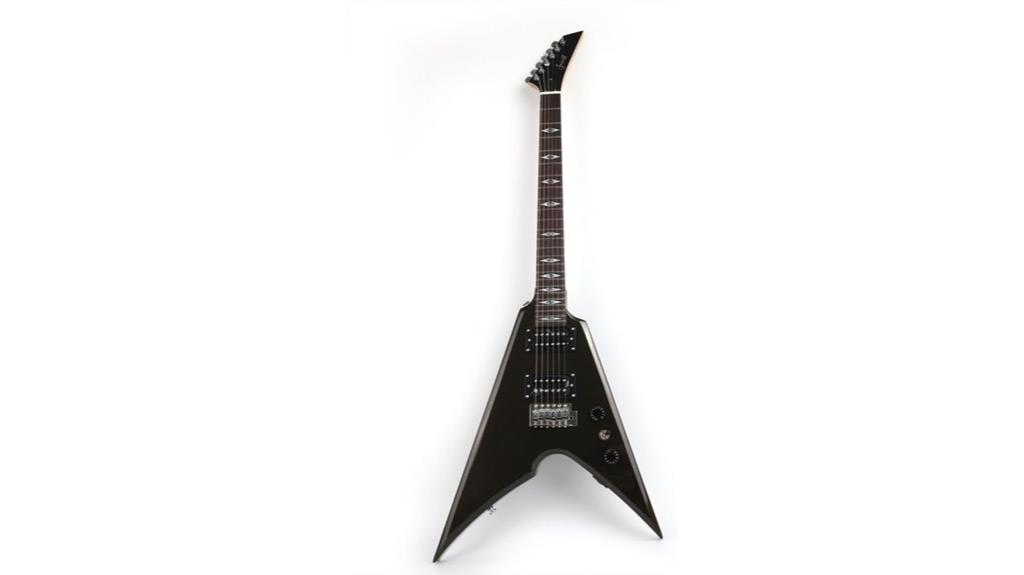
The Fojill FHM-601 stands out as an exceptional choice for guitarists seeking professional-grade features without the premium price tag, combining a solid mahogany body with a Canadian maple neck and genuine rosewood fretboard that delivers both visual appeal and tonal excellence. You’ll appreciate the H-H Alnico pickup configuration that produces warm, classic tones with substantial output power, while the stainless steel frets with rounded ends eliminate sharp edges for comfortable playing sessions. The bone nut enhances string vibration and tuning stability, complemented by a tremolo bridge system that maintains pitch accuracy during aggressive playing, making this 9.88-pound guitar surprisingly competitive against established brands like Ibanez and Jackson.
Best For: Guitarists seeking professional-grade features and sound quality at an affordable price point, whether they’re intermediate players upgrading from entry-level instruments or experienced musicians looking for a reliable backup guitar.
Pros:
- High-quality construction with mahogany body, Canadian maple neck, and genuine rosewood fretboard that rivals more expensive guitars
- H-H Alnico pickup configuration delivers warm, classic tones with strong output power suitable for various music styles
- Comfortable playability features including rounded stainless steel frets, bone nut, and tremolo bridge system for enhanced tuning stability
Cons:
- At 9.88 pounds, the guitar may cause comfort issues during extended playing sessions compared to lighter alternatives
- Some users reported minor quality control issues such as short frets that may require attention
- Being manufactured in China, it may lack the prestige factor associated with guitars made in traditional guitar-making regions
Jackson JS Series RR Minion JS1X, Amaranth Fingerboard, Satin Black
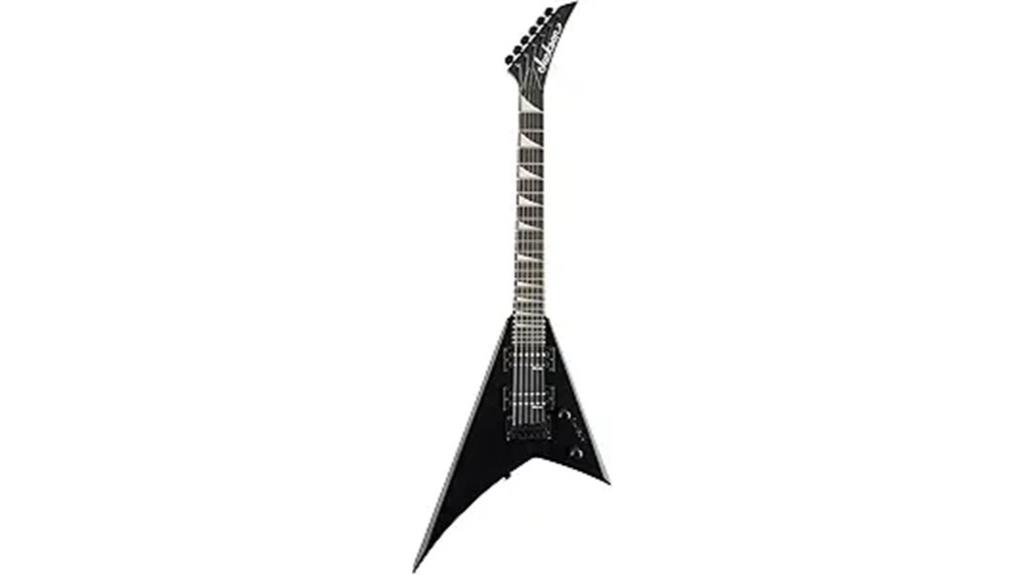
For young guitarists ready to embrace the iconic Flying V aesthetic without wrestling with a full-sized instrument, Jackson’s JS Series RR Minion JS1X presents an ideal gateway into the world of aggressive rock tones and distinctive angular design. This 2/3-scale guitar features a 22.5-inch scale length that accommodates smaller hands while delivering surprisingly robust sound through its dual high-output humbucking pickups. The poplar body construction keeps the weight manageable at just under six pounds, while the maple neck incorporates graphite reinforcement rods for enhanced stability. Though some users report tuning stability issues that heavier gauge strings can resolve, the amaranth fretboard provides smooth playability across all 24 frets, making this an excellent starter instrument for aspiring metal and rock players.
Best For: Young guitarists and beginners who want to learn rock and metal styles with an iconic Flying V design on a smaller, more manageable 2/3-scale instrument.
Pros:
- Compact 22.5-inch scale length with lightweight 6-pound body makes it easy for smaller hands and younger players to handle
- High-output dual humbucking pickups deliver robust rock and metal tones with good sustain across 24 frets
- Maple neck with graphite reinforcement rods and smooth amaranth fretboard provide enhanced stability and playability
Cons:
- Tuning stability issues reported by users, often requiring heavier gauge strings to resolve
- Quality control concerns with some instruments arriving damaged and cosmetic defects upon delivery
- Not well-suited for adults or players with larger hands due to the reduced scale size
WestCreek CERBERUS Solid Body Electric Guitar (CB-2)
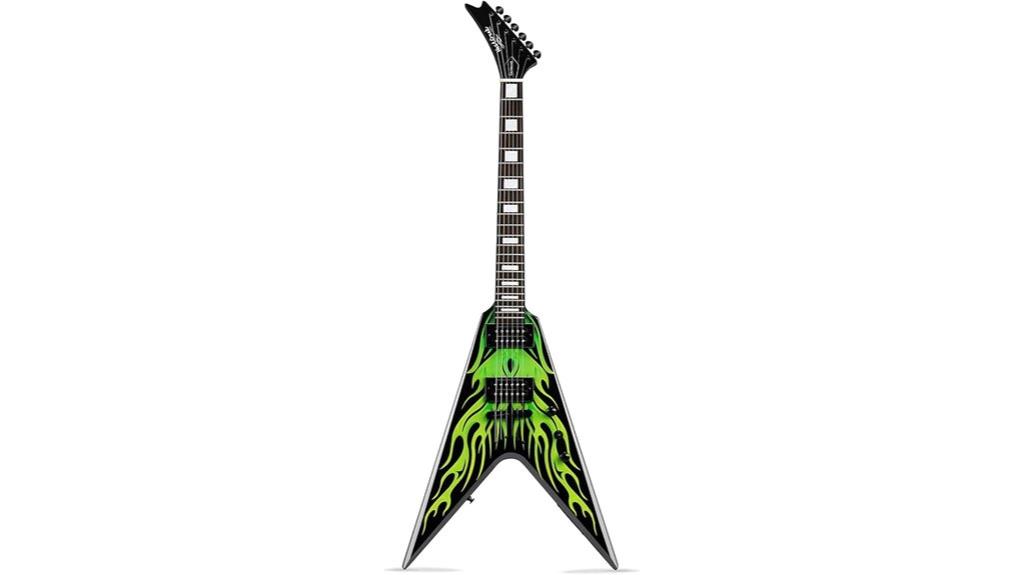
Bold musicians seeking that unmistakable heavy metal edge will find their sonic weapon in the WestCreek CERBERUS Solid Body Electric Guitar (CB-2), a striking Hot Green instrument that doesn’t mess around when it comes to delivering aggressive tones. The mahogany body construction provides deep resonance with excellent sustain, while the hard maple neck offers comfortable playability with measurements of 21mm at the 3rd fret, expanding to 22mm at the 12th fret for peak grip. You’ll appreciate the rosewood fingerboard‘s smooth feel and enhanced tonal quality, complemented by strings-through-body design that boosts sustain and tuning stability. The 628mm scale length strikes an ideal balance between playability and power for both stage performances and studio sessions.
Best For: Rock and metal guitarists who need an aggressive, high-output electric guitar with excellent sustain and tuning stability for both live performances and studio recording.
Pros:
- Mahogany body and hard maple neck construction delivers deep resonance with excellent sustain and comfortable playability
- Heavy metal pickups provide high output and aggressive tone specifically tailored for rock and metal genres
- Strings-through-body design enhances sustain and tuning stability for reliable performance
Cons:
- Limited to heavy metal and rock styles due to specialized pickup configuration
- Hot Green color may not appeal to musicians preferring more traditional or versatile finishes
- High-output pickups may not be suitable for cleaner playing styles or genres requiring more dynamic range
KGD Relic V Electric Guitar, Mahogany Body and Neck
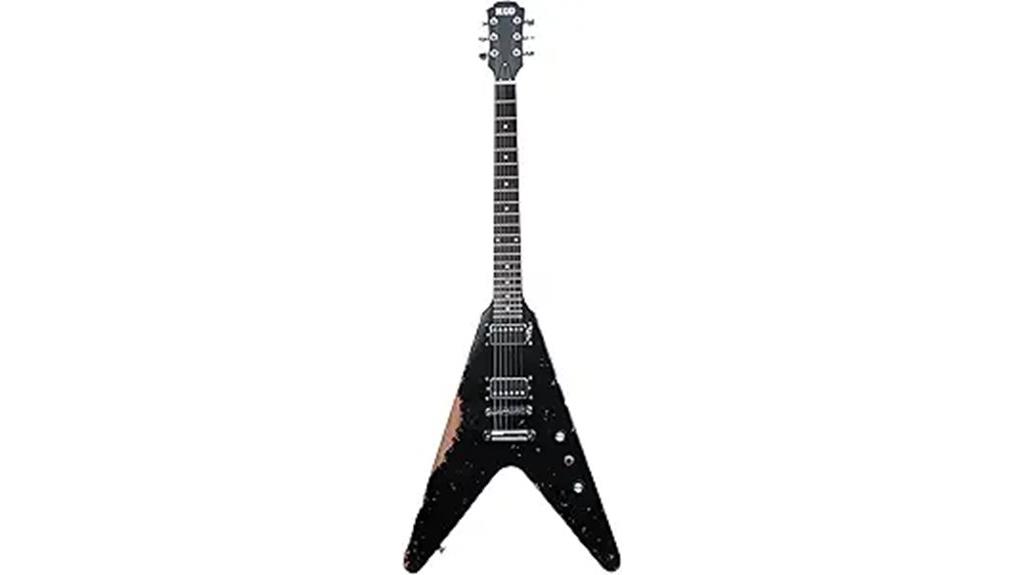
Musicians seeking an affordable entry into the distinctive Flying V aesthetic will find the KGD Relic V Electric Guitar offers a compelling combination of classic mahogany construction and heavy metal styling, though you’ll need to temper expectations given its budget-friendly positioning. The mahogany body delivers decent tonal foundation, while the C-shaped neck provides comfortable playability that reduces hand fatigue during extended sessions. However, you’ll likely encounter quality inconsistencies that plague budget instruments, including subpar pickups requiring eventual replacement, crackling electronics, and inconsistent fret work that may need professional attention to achieve peak performance standards for serious playing.
Best For: Budget-conscious musicians, beginners wanting to explore the Flying V aesthetic, or players looking for a project guitar to customize and upgrade over time.
Pros:
- Mahogany body and neck construction provides solid tonal foundation and comfortable C-shaped neck profile
- Distinctive Flying V design with relic styling offers classic heavy metal aesthetics at an affordable price point
- Tune-O-Matic bridge system and stainless steel frets provide good tuning stability and smooth playability
Cons:
- Subpar pickups and electronics issues including crackling volume pots and faulty toggle switches
- Quality inconsistencies in fret work, paint job, and overall construction requiring potential professional setup
- Mixed customer reviews with only 3.5/5 rating indicating reliability and performance concerns
Factors to Consider When Choosing a Flying V Guitar
When I’m selecting a Flying V guitar, I’ve learned that five critical elements will make or break your playing experience, and I’ll walk you through each one so you don’t make the same expensive mistakes I did early on. The body wood fundamentally shapes your tone character, pickup configurations determine your sonic versatility, and neck profiles directly impact how comfortable those long practice sessions feel in your hands. Bridge systems affect tuning stability and sustain quality, while scale length influences string tension, fret spacing, and overall playability, making these factors essential considerations rather than mere specifications.
Body Wood Types
Although many guitarists focus primarily on pickups and amplifiers when shaping their sound, I’ve found that the body wood of your Flying V actually serves as the fundamental foundation that determines how every note will resonate, sustain, and respond to your playing style. Mahogany remains my top recommendation for rock and metal players, delivering that warm, full-bodied tone with exceptional midrange presence that cuts through dense mixes. Poplar offers an excellent budget-friendly alternative, providing lightweight construction with surprisingly balanced tonal qualities that enhance both sustain and resonance. The density and grain patterns directly affect your guitar’s attack characteristics, with denser woods typically producing more sustain and clarity, while lighter options make extended playing sessions more comfortable.
Pickup Configuration Options
Since body wood establishes your Flying V’s foundational voice, the pickup configuration you choose will ultimately determine how that voice translates through your amplifier, and I’ve learned that most Flying V guitars excel with dual humbucker setups that deliver the thick, aggressive tones these instruments were designed to produce. I’ll admit I was skeptical about active pickups initially, but certain Flying V models incorporate active and passive combinations that provide remarkable versatility for different playing styles. The coil-splitting feature on premium models allows you to access single-coil brightness when needed, though honestly, I find myself staying in humbucker mode for that sustained, powerful output that cuts through dense mixes perfectly.
Neck Profile Comfort
Comfort becomes the deciding factor between a guitar you’ll reach for daily and one that collects dust, and I’ve discovered that the neck profile on Flying V guitars varies dramatically between manufacturers, with some offering thick U-shaped profiles that fill your palm completely while others feature slimmer C-shaped contours that accommodate faster playing styles. I particularly appreciate rolled fingerboard edges, which smooth out the sharp corners and allow my fretting hand to glide effortlessly across the neck during extended sessions. The 25.5-inch scale length that’s standard on most Flying Vs creates moderate string tension, though I find this works well for both rhythm work and lead playing. Jumbo frets paired with quality neck materials like maple or mahogany enhance both comfort and sustain considerably.
Bridge System Choices
Beyond neck feel, the bridge system you choose will fundamentally shape how your Flying V responds to your playing, and I’ve learned through countless hours of testing that this single component affects everything from your guitar’s sustain characteristics to how often you’ll find yourself reaching for a tuner. Fixed bridges deliver rock-solid tuning stability and enhanced sustain, making them perfect for heavy riffing and aggressive techniques that define Flying V territory. While Floyd Rose tremolo systems offer expressive pitch manipulation that can elevate your solos, they’ll demand more frequent tuning adjustments and careful setup consideration. Hardtail bridges provide the sweet spot for many players, combining straightforward maintenance with reliable performance, though you’ll sacrifice the dramatic dive bombs that tremolo systems enable.
Scale Length Impact
Although many players obsess over pickups and wood types, I’ve discovered that scale length arguably wields more influence over your Flying V’s fundamental character than any other single specification. The standard range spans 24.75 to 25.5 inches, and I’ve found this seemingly minor difference creates dramatic tonal and playability variations. Longer 25.5-inch scales deliver brighter tones with tighter string response, perfect for aggressive shredding and precise articulation. Conversely, shorter 24.75-inch scales offer reduced string tension, making note bending effortless and enhancing expressive lead work. The fret spacing also changes considerably, affecting finger reach and comfort, particularly for players with smaller hands who might struggle with extended scale lengths.
Hardware Quality Standards
While scale length shapes the foundation of your Flying V’s personality, the hardware components you select will ultimately determine whether that personality shines through consistently, night after night. I’ve learned that investing in quality tuning machines, whether vintage-style or locking varieties, makes the difference between constant retuning and rock-solid stability during aggressive playing sessions. String-thru-body bridge designs enhance the sustain and resonance that Flying V guitars are renowned for, while premium nut materials like Graph Tech NuBone improve string vibration transfer compared to cheaper alternatives. Don’t overlook the electronics either—CTS potentiometers and quality wiring greatly impact your tonal clarity and responsiveness, ensuring your Flying V’s voice comes through with the precision it deserves.
Price Range Considerations
Three distinct price tiers define the Flying V market, and I’ve found that understanding these categories helps you match your budget with realistic expectations for quality and performance. Budget models around $200 offer basic components but typically require setup costs and potential hardware upgrades to achieve the best playability. Mid-tier options, ranging from $400-800, incorporate higher-quality pickups and hardware that deliver noticeably enhanced tone and feel. Premium Flying Vs exceeding $1,500 showcase superior craftsmanship, rare tonewoods, and custom pickups that justify their higher price tags through exceptional sound quality and aesthetics. I always factor in additional costs like shipping, protective cases, and necessary accessories when calculating the total investment, since these expenses can considerably impact your overall budget planning.
On a final note
I’ve researched these Flying V guitars, each offering distinct tonal characteristics, build quality, and aesthetic appeal that’ll satisfy different playing styles and budgets. Whether you’re drawn to Epiphone’s sparkle finish, Jackson’s aggressive King V profile, or WestCreek’s unique Cerberus design, there’s a V-shaped axe here that matches your musical vision. Consider your genre preferences, pickup configurations, and neck specifications carefully—the right Flying V will transform your stage presence completely.

